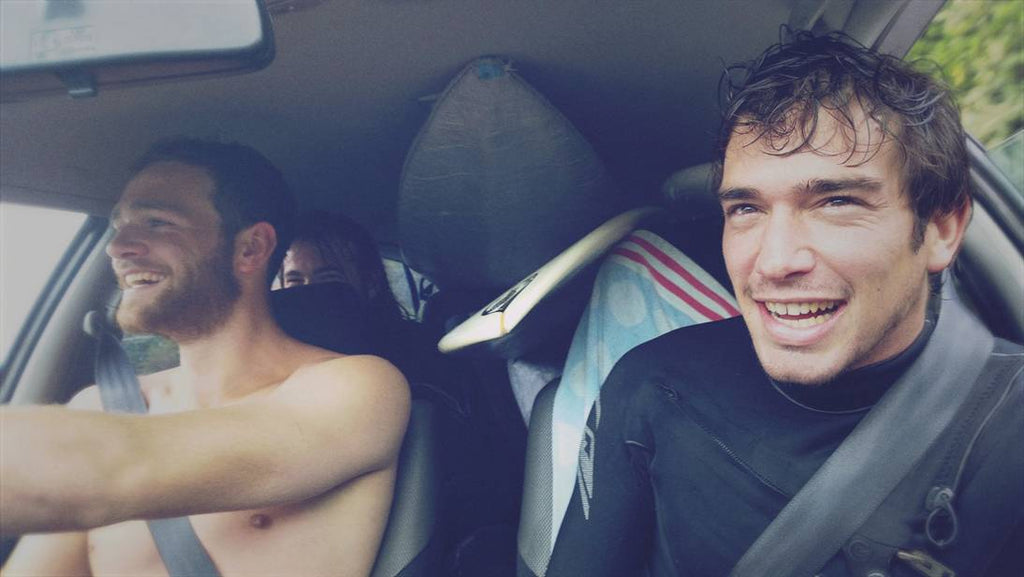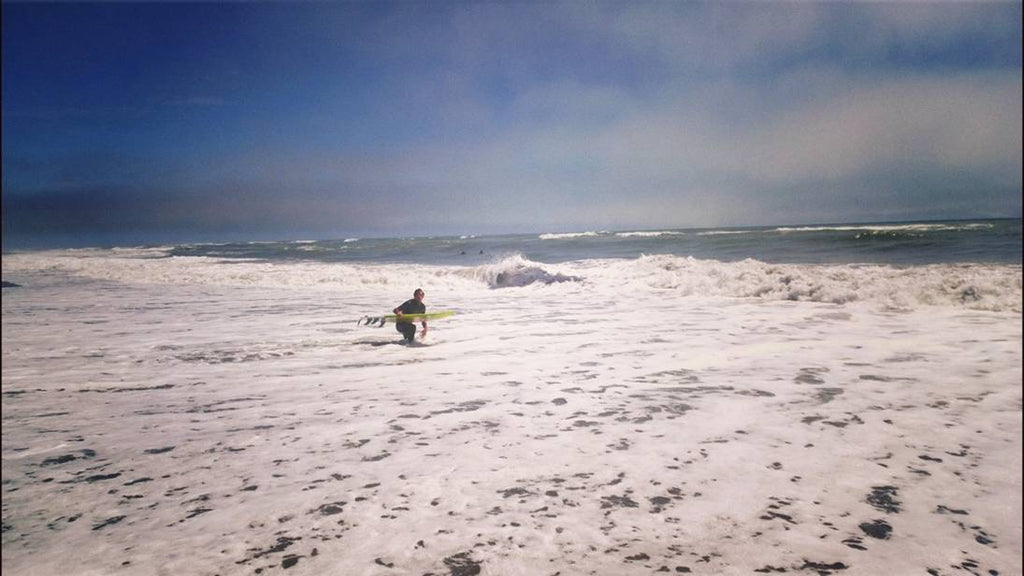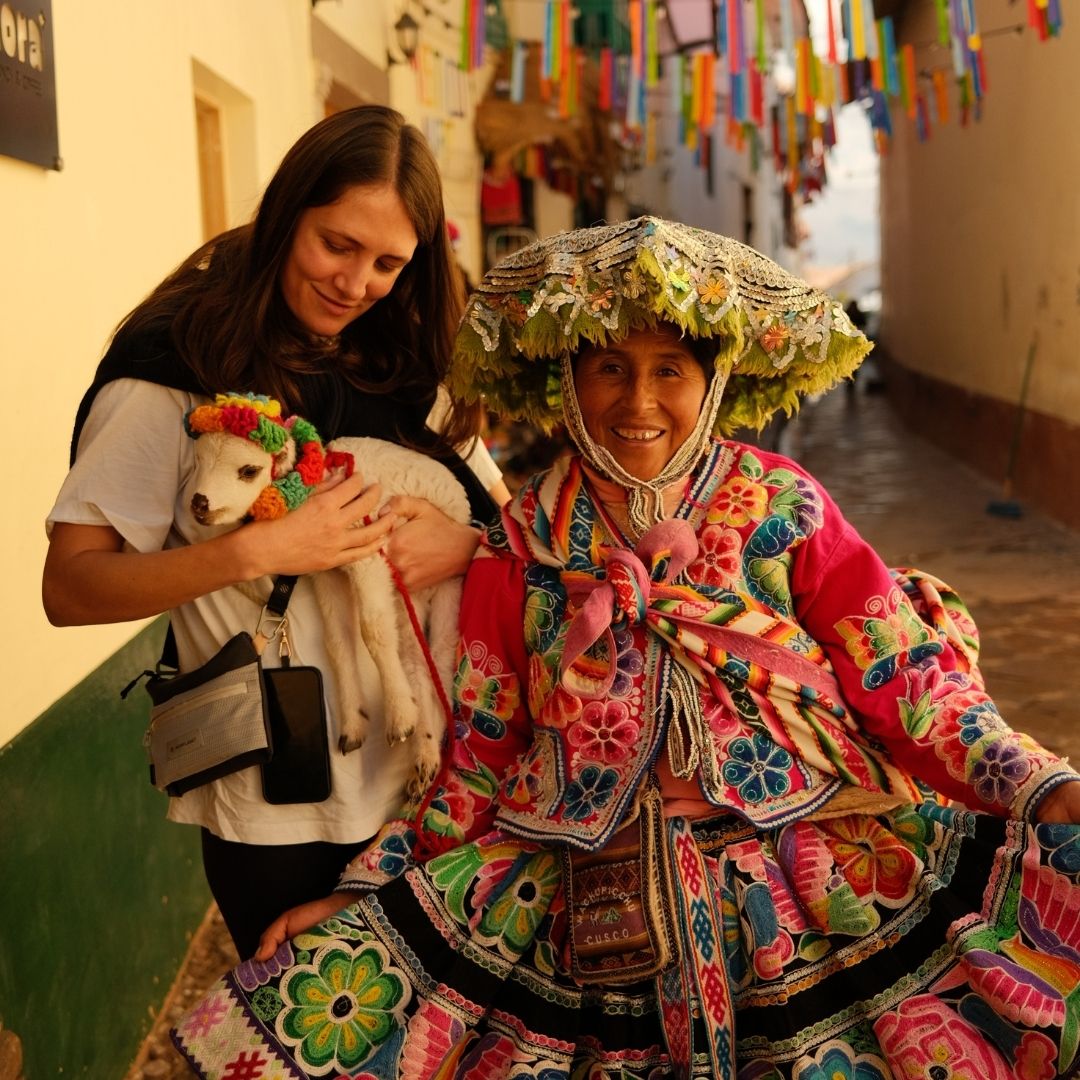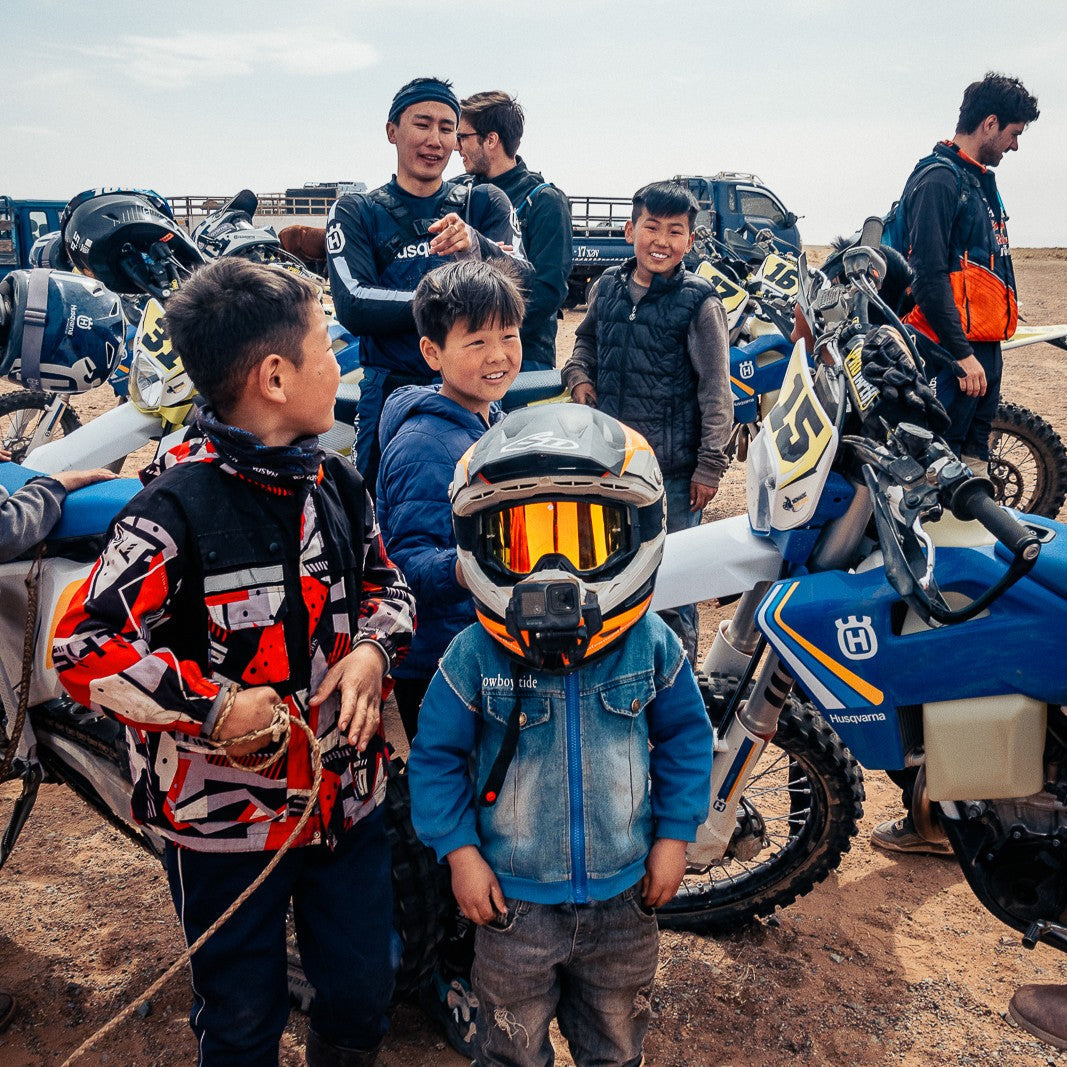FOLGE DIESEM FAHRRAD NICHT
Jede Woche ein Video und ein Blogpost, dazu ein Bild pro Tag auf seinem Instagram-Account. Auf diese Weise veröffentlicht Atila seine Reise durch Neuseeland.

Neuseeland - 1 Spanier - 1 Fahrrad - 16.000 km - 10 Monate
Kapitel 1: Start
Den Startpunkt in Dunedin zu erreichen war verrückt. Eine Nacht am Flughafen in London, mehrere verspätete Flüge, 32 Stunden Flug, ein verlorener Reisepass und die gesamte Ausrüstung verspätet. Aber keine Sorge, ich war mittendrin im Abenteuer. Erstes Ziel: Der Nationalpark "The Catlins". In diesem Teil der Insel sind Klima und Landschaft ziemlich extrem. Es gibt viele Berge und das Wetter ist sehr wechselhaft, so dass es mit dem Fahrrad und einigen zusätzlichen Kilos nicht einfach ist.
Auf der Suche nach guten Wellen bin ich mehrere Tage lang in die Pedale getreten und habe schließlich die Curio Bay erreicht. Der Ort war erstaunlich. Die Bucht ist ideal für Delfine, also ging ich mit ihnen und mit Julian, einem charmanten Deutschen, surfen. Dann traf ich einen Typen mit einem verrückten Gesicht, der mich fragte, ob ich an einem "geheimen Ort" surfen gehen wollte, den fast niemand kennt. Der Typ zeichnete eine Karte und ich folgte seinen Anweisungen und suchte nach einem Bauernhof mit Schafen und der Nummer 119. Der Geheimspot war umwerfend, unterhalb der Klippe brach eine unglaubliche Welle.

Kapitel 2: Invercargill > Te Anau
Die Natur hat sich sehr verändert. Fiordland ist wunderschön, mit Gipfeln bis zu 2.000m, aber das Wetter ist grauenhaft. Es regnet fast jeden Tag, ideal zum Radfahren...
Ich habe Marc und Jo getroffen. Marc zu erzählen, dass die Suche nach der perfekten Welle fast genauso aufregend oder sogar aufregender ist als das Surfen selbst. Und es ist tatsächlich wahr. Wenn ich mit dem Fahrrad auf Wellensuche gehe, fühle ich mich unglaublich aufgeregt bei dem Gedanken, dass ich einen besonderen Ort finden werde, und das ist das Abenteuer.

Kapitel 3: Nirgendwo > Queensland
Von Te Anau nach Wanaka war die schönste Strecke, die ich bisher gefahren bin. Jetzt gibt es auf allen Seiten hohe Berge und endlose Hänge. Die Seen liegen auf dem Weg. Der Mavora-See war eine echte Überraschung in der Mitte einer langen Etappe, ich schlief dort und startete am nächsten Tag eine Tour durch das Tal zum Walter Peak. Den See mit dem Dampfschiff zu überqueren und Queenstown zu erreichen, war ein unglaubliches Erlebnis. Wenn es nur immer so wild wäre, aber leider ist es in Neuseeland an den meisten Stellen verboten, wild zu campen. Zum Glück gibt es Regeln, die man brechen kann.

Kapitel 4: Wanaka > Hokitika
Wanaka, ein Ort, der von einer unglaublichen, unbekannten Natur umgeben ist.
Ich wusste, dass die "wilde" Westküste hart sein würde, aber eine solche Tortur hatte ich nicht erwartet. Als ich die Gebirgswüste überquerte und das Meer erreichte, hatte ich das Gefühl, am letzten bewohnten Ort der Erde zu sein. Hinter mir: Gletscher, riesige Wasserfälle und sehr dunkle Wolken. Vor mir: geradlinige, endlose Strände, Felsbrocken, Baumstämme und riesige Bäume. Ein dunkles, stürmisches Meer, das Gegenteil von dem, was man sich vorstellt, wenn man ein paar Wellen erwischen will.

Kapitel 5: Greymouth
Ich habe mich einfach in das Dorfleben integriert, und die Leute nennen mich bei meinem Namen, wenn ich auf mein Fahrrad steige. Tessa, Tony und ich haben uns durch Jo kennengelernt. Sie haben mich aufgenommen, als ob ich sie schon ein Leben lang kennen würde, und sie haben mich wie einen Sohn behandelt. Ich glaube, das ist Teil der Kultur hier. Ich weiß nicht, warum, vielleicht weil sie Maori sind, aber auf jeden Fall sind die Menschen in Neuseeland sehr gastfreundlich.
Wenn du auf der anderen Seite der Welt im Wasser bist, große Wellen fängst und die Leute um dich herum darauf brennen, eine Welle mit dir zu teilen, anstatt sie dir zu klauen (weil sie Einheimische sind), wird mir klar, dass das Lebenstempo hier genau das ist, was wir in Europa verzweifelt vermissen. Alles ist einfach. Man kann seine Schlüssel stecken lassen und die Fenster öffnen, während man surft. Die Häuser haben offene Türen und man kann barfuß zum Supermarkt gehen.


Kapitel 6: Punakaiki > Karamea
Die Strecke von Greymouth nach Karamea war voll von perfekten Wellen. Das Einzige, was man brauchte, war ein Paar Mut, um ins Wasser zu gehen. Lange Strände, seltsame Felsformationen, Flüsse und vor allem sehr wenige Menschen.
Jude, ein Kontakt, den mir ein Freund vor einiger Zeit vermittelt hatte, lud mich ein, in ihrem Haus zu wohnen. Dieses Haus wäre der Traum vieler Menschen in Europa. Ich hatte das große Glück, ein paar Tage mit ihr und ihrer Tochter zu verbringen. Wir machten Radtouren, schauten auf die Wellen und genossen dieses Refugium.

Kapitel 7: Westport > Takaka
Die Idee war, die Nordspitze der Südinsel zu erreichen, den "Farewell Split", der von Westport und Karamea aus ziemlich nah ist. Aber es gibt einen Nationalpark, der durchquert werden muss, und es ist nicht erlaubt, ihn mit dem Fahrrad zu durchqueren, also musste ich eine interne Route nehmen (300 km mehr). Die Straßenkarte schien unmöglich, es war eine endlose Folge von Kurven.
Die Tage mit Marco und seiner Mutter waren sehr lustig, wir haben gegessen, sind zusammen gereist, haben tolle Strände gesehen und sind bei sehr kaltem und klarem Wetter alleine gesurft.
Ich wüsste wirklich nicht, wie meine Reise ohne Surfen verlaufen würde. Klar, wenn man surft, ist es schwer, sich eine Reise ohne Surfen vorzustellen. Aber ich meine, ich weiß nicht, ob all diese Dinge passiert wären, wenn ich nicht von meinem Surfbrett begleitet worden wäre.

Kapitel 8: Motueka und Marahau
Ich konnte den Abel Tasman nicht mit dem Fahrrad überqueren, weil das nicht erlaubt ist. Also musste ich wieder eine interne Route nehmen, was bedeutet, den steilsten Berg Neuseelands, den Takaka Hill, zu erklimmen. Der 800 m hohe Berg trennt die Golden Bay von der Tasman Bay, ich brauchte 2 Stunden, um den Berg zu erklimmen. Ich weiß, im Schneckentempo, aber mit dem ganzen Gewicht musste ich langsam gehen und mir all die Touristen in ihren Vans vorstellen, die einen Typen sehen, der mit einem Surfbrett und einem tomatenroten Gesicht den steilsten Berg Neuseelands erklimmt.
Marahau, ein Ort mit der schönsten Natur, die ich bis jetzt gesehen habe. Ich konnte es nicht glauben, hinter mir: Das Meer in der Ferne und der Beginn des Parks, ein paar Kühe in der Mitte, schwarze Pferde und Vögel aller Art. Neben mir: ein lautes Rauschen von reinem Wasser und ein paar Enten. Am Morgen besuchte ich die Strände von Abel Tasman. Ich war dort, nur ich, strahlender Sonnenschein, klares Wasser, ein unendlicher Horizont und hinter dem Wald das brutale Meer. Das konnte ich mit niemandem teilen.
Kapitel 9: Marahau > Wellington
Ich habe einige Illusionen gemacht, als ich Picton unter extremen Bedingungen erreichte: Regen, Gewitter und Windböen von 45 km/h. Ich hörte das Geräusch eines großen Schiffes. Es war bereits angekommen. Die 13-Uhr-Fähre. Ich weiß wirklich nicht wie, aber auf magische Weise kam ich pünktlich an.
Ich, ein Neuling auf der Nordinsel, hatte die Hauptstadt vor mir. Vielleicht bin ich von meinen Kindheitserinnerungen und dem Cover von "Ibiza Mix 95" geprägt, aber ich hatte den Eindruck, dass der Akt, eine Fähre zu nehmen, um von einer Insel zur anderen zu gelangen, den Wechsel in eine andere Welt bedeutet.

Kapitel 10: Wellington
Ich bin in Wellington, der "coolsten kleinsten Hauptstadt der Welt", wie die Einheimischen hier sagen.
Ashleigh und ihre Mitbewohner haben mich herzlich empfangen und mich an all die coolen Orte mitgenommen. Ich bin zum Baden gegangen und von der Patacha gesprungen, ich bin im Skatepark geskatet, ich bin zum Mount Victoria gefahren, ich habe in der Lyall Bay und in der Houghton Bay gesurft, ich habe eine Party verlassen, bin in den Zirkus gegangen, habe mit Chilenen gekocht, eine Regatta gesehen und interviewt, ich habe gesungen und mit Leuten auf der Straße Gitarre gespielt.
Ich finde es wirklich toll, dass die Kiwis die nettesten und freundlichsten Menschen der Welt sind.

Kapitel 11: Wellington > Whanganui
Der Karte zufolge schien die West-/Südwestküste von Wellington wunderschön zu sein. Ich vermisste es, an einem ruhigeren Ort zu sein, in meinem Zelt zu schlafen und in der Nähe des Wassers zu sein. Die Strecke war wunderschön, zum ersten Mal spürte ich den Herbst light. Das Wetter hatte sich geändert. Es war sonnig mit einem sehr kalten Wind. Vorbei an kleinen kristallklaren Flüssen, grünen Wiesen, auf denen Kühe, Enten und Ziegen ihre Tage verbringen. Nirgends ein Mensch zu sehen.
Ich komme zum Makara Beach, einem wunderschönen Strand, der von Felsen und hohen Bergen umgeben ist. Herbst light, klares Wasser, ruhiges Meer und ich habe noch niemanden gesehen.

Kapitel 12: Whanganui > Opunake
Ich beobachtete das Meer wie ein wütendes Kind, weil es keine Wellen gab. Neben mir saß ein Mann in seinem Auto und schaute ebenfalls auf das Meer. Wenn der Tag bewölkt ist und man jemanden sieht, der auf das Meer schaut, ist er wahrscheinlich ein Surfer, ein Fischer, ein Taucher oder jemand, der oft ans Wasser geht.
In Hawera habe ich wie ein König gelebt, deshalb wollte ich auch so lange wie möglich bleiben. Dean, seine Familie und ich verbrachten die Tage zusammen und machten die Zeit zu etwas ganz Besonderem. Das Tüpfelchen auf dem i war, als Phil mich fragte, ob ich gerne fliegen würde. Wir flogen über alle berühmten Wellen in der Umgebung von Opunake. Er hat mich sogar das Flugzeug fliegen lassen. Ihr könnt euch vorstellen, wie gerne ich Flips oder andere Manöver machen wollte, aber Phil sagte mir, ich solle es ruhig halten".
Opunake, das Paradies der Wellen. Der Winter ist da. Sie gehen in kurzen Ärmeln, aber ich trage lange Hosen mit engen, ein Baumwollhemd und eine Jacke.
Kapitel 13: Opunake > Oakura
Ich kann das tun, was ich am meisten wollte und verdient habe: surfen! Es ist ganz anders als das, was ich gewohnt bin. In Europa gibt es verschiedene Stellen, an denen viele Menschen im Wasser sind. Hier muss man den Bauern um Erlaubnis bitten, dann die Kühe begrüßen, über den Zaun klettern und eine halbe Stunde lang laufen, um ins Wasser zu kommen.
Ich hätte nicht gedacht, dass die Spots so abgelegen sind, aber genau das macht sie noch besonderer und exotischer. Perfekte Wellen und sie sind noch unberührt.

Kapitel 14: Oakura > New Plymouth
Da, wo ich herkomme, regnet es nicht, also bin ich nicht an Regen gewöhnt und ich mag Regen nicht. Vor allem nicht, wenn es eine ganze Woche lang regnet, ohne auch nur eine Sekunde zu stoppen. Ich erinnerte mich daran, dass mir jemand gesagt hatte, ich solle an einen schönen Ort gehen, wo die Menschen mich herzlich willkommen heißen würden. Ein riesiges Holzhaus an einem Fluss, umgeben von einem Wald. Der Besitzer hat dieses Haus auf der Suche nach guten Wellen gebaut und vermietet einige Zimmer für den Lebensunterhalt. Es war ein lustiges Haus. Es gab eine Sauna, einen Fluss mit einer Straße voller Überraschungen, Bretter überall (Skate, Surf, SUP), Musikinstrumente, Kajaks, Hunde und eine tote Ratte auf dem Dach.
Am Abend kam ich in New Plymouth an, so gegen 18 Uhr, aber es war schon dunkel und kalt. Toby, ein deutscher Arzt, den ich auf meiner Reise kennengelernt hatte, nahm mich mit zu seinem Freund und ein paar Tage später sagten die Leute schon, ich sei die spanische Version von Toby. Er ist die Art von Mann, die man gerne wäre; immer freundlich und nett zu allen, immer bereit zuzuhören, ein Freund für alle und ein wirklich guter Kerl.

Kapitel 15: New Plymouth > Raglan
Ich brauche wirklich neue Beine, denn meine sind schon überlastet. Ich hatte die glänzende Idee, durch die Landschaft zu fahren, anstatt die Hauptstraße zu nehmen. Nun, ich glaube, das war die schlechteste Idee, die ich auf der ganzen Reise hatte. Die Wahrheit ist, dass die Strecken unglaublich schön waren. Ich bin durch sehr authentische Dörfer gefahren, weit weg von allem, und die Menschen haben mich mit einer Freundlichkeit aus einer anderen Welt empfangen. Aber es war ziemlich schwer, das Surfbrett über die unbefestigten Straßen zu tragen und die Pisten waren die Hölle. Es war super kalt, aber die Kälte hat mich nicht gestört, es ist der Regen, der schlimmer als je zuvor ist.
Ich weiß nicht warum, aber ich fing an, mir vorzustellen, wie ich von außen aussehe: schwitzend wie ein Schwein, ein Kopf rot wie eine Tomate, ein Fahrrad mit einem Surfbrett und ein spanischer Mann am anderen Ende der Welt, der an einem sehr steilen Hang gefickt wird. Ich fing so sehr an zu lachen, dass ich aufhören musste zu fahren.








